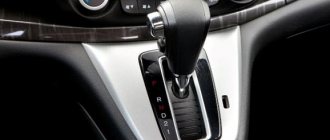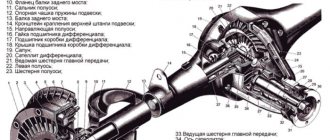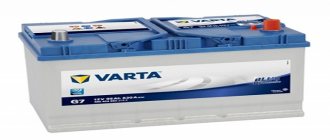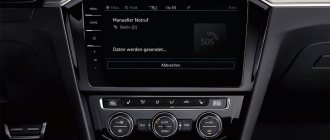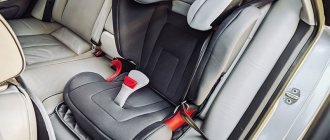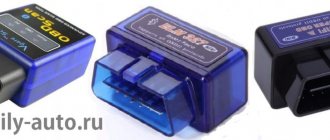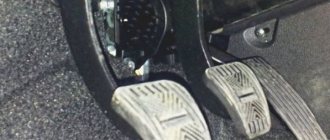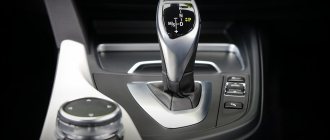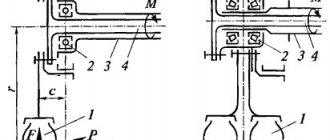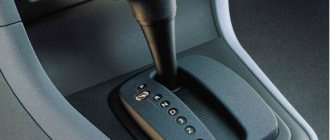To understand what tiptronic is, you need to study the features of its operation in relation to automatic transmission and manual transmission. Then the advantages and disadvantages of the gearbox, which raises so many questions among motorists, will become obvious. If we talk about the definition, then tiptronic is a gearbox that belongs to the automatic class, but has the ability to switch modes manually.
A similar system was created to increase control over engine operation. Using a tiptronic box, the driver chooses when to switch operating modes on different sections of the highway. However, against the background of semi-mechanical control, certain disadvantages of the device arise. When choosing such a gearbox, you need to understand that it is more difficult to control than a conventional automatic or classic mechanics.
From history it can be noted that tiptronic was originally used in sports cars. And the name of the gearbox was patented by the automobile manufacturer Porsche, which released the first car with similar controls in 1990. The definition often hides other names that are essentially classic tiptronic: steptronic, espatic, touchtronic. The box is widely used in robotic technology and CVTs. And when talking about a tiptronic box, most motorists mean an automatic transmission, not a manual transmission.
Design and principle of operation of tiptronic
The structure of the tiptronic gearbox has the same structure as that of a classic automatic transmission. However, it is possible to switch the mechanism to manual control mode. As for the movement of the car, it is identical to cars equipped with an automatic transmission.
The operation of the system is closely related to the switches located in the gearbox selector. Some cars have additional switches on the steering wheel:
- the selector has from 1 to 3 switches;
- 1 is always responsible for activating the mode;
- 2 can adjust downshift or upshift;
- 3 is responsible for additional adjustment of increase or decrease.
From the tiptronic switches, signals are sent to the electronic transmission control unit, which reacts to gear changes.
Among the features of this algorithm are the following. When upshifting, the selector is in the forward position; when downshifting, it is in the rear position. The classic algorithm looks different: the selector goes back to upshift and, conversely, is located in front to downshift.
The tiptronic box uses 2 operating modes:
- manual control - the driver independently selects the gear, limiting the automatic transmission in its independent choice;
- automatic control - the box uses modes P, N, D, R, but there is always a control groove nearby through which it switches to mechanical mode.
To disable the tiptronic gearbox, you must move the selector to position D. In most cars, the selected gearbox operating mode is displayed on the control panel. Some cars have a system of steering wheel paddle shifters that, when pressed, turn the tiptronic on or off.
Operating principle of automatic transmission with tiptronic
In order for a box to be called a tiptronic, it must meet certain criteria:
- lack of shaft;
- presence of an automatic transmission hydraulic system;
- use of planetary gearboxes;
- presence of torque converter locking in each gear;
- control occurs through an electronic unit.
An important condition for the normal operation of the tiptronic box is the presence of a perfect connection between the wheels and the motor. This balance was achieved only after the cars were improved. Thus, cars made in the 80s and earlier cannot be equipped with tiptronics.
Important! The gearboxes of those years, when blocked, received catastrophic shock loads that occurred when downshifting. This led to rapid wear of transmission elements.
Over time, materials and additional elements appeared in the vehicle control system, which increased the wear resistance of the vehicle. All this made it possible to develop the classic tiptronic, which is now used in many cars without problems.
So, the operating principle of the classic tiptronic box comes down to the following:
- To activate the function, you must move the automatic transmission lever to the manual position. For cars equipped with steering wheel paddle shifters, this element is used for activation.
- As soon as the electronic control unit receives a signal to change the mode, it activates the software module.
- Next, the program is responsible for changing gears manually by the driver.
Switching up and down is carried out sequentially; you cannot skip modes.
How to use the tiptronic box
In normal mode, the tiptronic box uses section D, and the actions of the machine are controlled by the on-board computer. When entering the T section, the driver gains full control of the gear. If the tiptronic is not used for a long time, the on-board computer itself activates the automatic transmission.
How to switch tiptronic
The tiptronic gearbox is equipped with a classic lever and 2 slots for control - in automatic and manual mode. Typically, switching from a manual transmission or automatic transmission requires the driver to undergo some retraining and get used to the new system.
Important! Automatic mode has the classic letters on the panel - D, N, R, P.
In most cases, to activate tiptronic, you need to switch the lever, or use paddle shifters and buttons on the steering wheel. To activate, do the following:
- The lever is moved to the left or right (T-type section).
- Move the lever back and forth to upshift and downshift. Typically, the side with “+” written on it indicates an upshift, and “-” indicates a downshift.
- Also, the buttons or paddles located on and below the steering wheel are designated “+” and “-”.
After activating one mode or another, you can monitor the status of the box on the electronic display of the control panel.
The on-board computer continues to control the operation of the car even in mechanical mode. So, he is responsible for protecting the gearbox and engine from actions that can cause harm. For example, if the car stops in the first gear mode, the electronic unit will not allow the motor to turn off.
Some cars are equipped with special programs - sports and winter. When using the first program, the tiptronic transmission maintains high engine speeds even in first gear. This is necessary for maneuvering, overtaking and instant acceleration. And the winter program protects against slipping on icy roads.
Types of gearboxes
Currently, the concept of an automatic transmission has become somewhat broader, since there are many types of it. Let's focus on two of them: classic and Tiptronic.
Classic automatic transmission
Without going into details, an automatic transmission is a gearbox in which speeds are switched automatically without driver intervention. But, in accordance with generally accepted engineering terminology, an automatic transmission is only a planetary part of the system that switches speeds.
Tiptronic
Tiptronic is the same automatic transmission that has the ability to change gears like a manual. The Tiptronic gearbox was first installed on a Porsche 911 in 1990, and a few years later they began to be equipped with BMW, Volkswagen, Audi and other cars. In normal mode, the box operates like a regular automatic transmission, but if necessary, it can be switched to mechanical mode at any time. This function makes it possible to bypass the computer and switch to direct manual control of the transmission.
Many drivers believe that this is not an independent type of gearbox, but only an additional automatic function.
Tiptronic is the best option for those car enthusiasts who want to combine the comfort of driving in automatic transmission mode and a sporty driving style.
Tiptronic has 4 or 6 speeds and the gearbox of this type operates very smoothly, any jerks are excluded. At speeds above the 1st hydraulic transformer is blocked, which ensures the transmission of torque virtually without any losses. A special program can analyze the road, outside temperature, engine and gearbox, and adapts to your personal driving style, thus calculating the best time to switch.
If you prefer manual gear shifting, then you only need one touch on the lever to move it forward to a higher speed or back to a lower speed. You do not need to depress the clutch pedal and there will be no loss of traction force. Changing speeds in manual mode is safe, since any erroneous shifts will be blocked. In case of braking, there is no need to shift the lever - the box itself will switch to low gear and then start from 1st speed.
The possibility of sports or winter driving is provided. If the sport mode is selected, the electronics make it possible to raise the engine speed to the upper range, while the car becomes more responsive during overtaking or in case of acceleration.
In winter mode, so-called traction control is provided on slippery roads; starting will take place from 2nd gear, and gear shifting will not only be earlier, but also smoother.
How does an automatic transmission differ from an automatic transmission with tiptronic?
The familiar “automatic” is a type of transmission that does not require driver participation. This means that it does not have to change gears, as this happens autonomously. In place of the usual manual transmission control lever, a selector is installed, which is responsible not for changing the gears themselves, but for the operating modes of the transmission. At the same time, the automatic transmission has all standard positions (park, reverse, neutral, forward and quiet).
Tiptronic is the same “automatic”, which has been improved and allows you to manually adjust the speed of the car if necessary. In addition to the standard positions, it also has “+” and “-” positions (the so-called sports mode). When the selector is set to the positive position, a transition to higher gear occurs. Accordingly, when the lever is lowered to minus, the speed decreases. Also, these buttons in the form of levers can be located on the steering wheel of a car. In this case, at high speeds or during maneuvers, the car owner does not have to remove one hand from the steering wheel. Thus, by moving the selector to sport mode, you can interfere with the operation of the automatic system and independently regulate the speed limit.
Most modern foreign cars are equipped with automatic transmissions, which by default have tiptronic. Some drivers prefer not to use it, while others like this additional option.
Pros and cons of tiptronic automatic transmission
Any device has its pros and cons, and the tiptronic gearbox is no exception. Among the advantages of the element are:
- Ease of driving a car with tiptronic gearbox . There is no need to constantly monitor the activated gear, as required by the manual transmission. But at any time the driver can switch to manual control for precise control of engine operation. There is no need to manually downshift; the on-board computer automatically prevents excessive loads.
- Impeccable comfort when on unfavorable roads . The tiptronic gearbox has a fixed low gear - there is no need to shift to a higher gear to overcome a bad section of the road. However, constant exposure to this mode can lead to increased wear of system elements.
- Maximum comfort when overtaking and cornering . The classic automatic transmission automatically switches to a high gear level if the car needs more acceleration when overtaking. Because of this, the speed drops. In manual control with tiptronic, the gear is fixed and the speed is in a stable mode. Due to this, the speed of maneuvers increases and overtaking time decreases.
- Easy start on icy surfaces . In case of ice, the tiptronic box protects the car from slipping, bypassing first gear.
- Reduced fuel consumption . Since the box independently selects the moment to change speed, the amount of gasoline consumed is reduced.
- Built-in damage protection . Tiptronic prevents the engine from reaching maximum speed, protecting it from wear.
- Approximately the same cost of cars . A vehicle with a classic automatic transmission is not much cheaper than one with a tiptronic.
If we talk about the disadvantages of an automatic transmission with tiptronic, then you should take into account several parameters that are affected by this element:
- Increase in vehicle weight . The box contains more parts and components, due to which the weight of the vehicle increases. And this affects both the cost of maintenance and the mobility of the machine.
- Lack of 100% control due to the use of an electronic control unit . Any car with a tiptronic gearbox is equipped with an electronic unit that has built-in protection against certain actions and settings. This can cause some discomfort if it is necessary to fix the gearbox at a certain stage (the box ignores the specified settings and works according to the program).
- The automatic machine works slower with tiptronic . This is because the signal travels through more nodes before execution.
What is better - tiptronic or classic automatic? If we consider the issue from a technical point of view, then tiptronic is the “golden mean”, which eliminates many of the disadvantages of automatic and manual transmissions, and also satisfies the needs of most motorists. A box with this function will be the best solution for drivers who have used only a manual transmission for a long time. After a little getting used to, users often switch to full automatic transmission, leaving the tiptronic for periods when turning and overtaking are needed.
Why is a classic automatic machine better?
First of all, standard automatic transmissions are much cheaper than their improved counterparts. If the tiptronic fails, you will have to spend an impressive amount of money on its repair, while an automatic transmission without any additions can be adjusted and “reanimated” independently. Automatic transmissions with a sport mode are distinguished by a large number of elements, so such devices are more difficult to pass even standard diagnostic measures. In this case, you will have to contact a specialized service.
“Automatic” is more to the taste of those who do not like to overtake and do not strive to pass difficult roads at high speeds. For example, for driving around the city to work or a store, an automatic transmission without any bells and whistles is more than enough.
Beginners who find it difficult to think about different driving modes also give greater preference to the “classic”. In addition, many novice drivers do not yet “feel the gears,” so they often “waste” torque. In such situations, it is much more convenient to use a full automatic transmission, which will perform all the necessary switching independently.
So tiptronic really is a more interesting driving mode that keeps the driver more connected to the car. It is worth choosing for those who often drive over rough terrain or perform complex turns. However, even without using the sport mode, the automatic transmission makes the life of the car owner much easier.
Malfunctions and repairs
Since the tiptronic box contains several more parts than a classic automatic transmission, malfunctions occur from time to time. The main thing that the driver must remember is careful operation and timely maintenance. Continued violation of the manufacturer's recommendations will result in damage and expensive repairs. Some of the most common tiptronic problems include:
- wear of parts - the oil pump and oil seal often suffer, in most cases a complete replacement of the elements is required, since the repair does not give the desired result for a long period of time;
- malfunctions of the ECU - the electronic unit is considered one of the most vulnerable parts, since regular use, even in gentle mode, does not protect against software errors. To diagnose the ECU, specialized computer equipment is required;
- oil-related problems - often motorists cause breakdowns themselves due to a desire to save money. The use of low-quality or unsuitable oil or its dilution with water increases the wear of parts tenfold.
Self-repair in all these cases is an irrational decision. At home, it is not possible to use professional equipment, and the knowledge of the car owner is usually not enough to detect the problem and fully eliminate it. In the worst case, independent actions lead to complete malfunction of the tiptronic, ECU and even the engine.
Comparative characteristics
Below is a table showing the advantages and disadvantages of gearboxes, and how tiptronic differs from automatic.
| Automatic transmission characteristics | Disadvantages of automatic transmission | Characteristics Tiptronic | Cons of Tiptronic |
| Easy to operate. | Not recommended for off-road driving | Full control while driving. | Much larger than a regular machine gun. |
| Installation and repair are cheaper than tiptronic. | Slipping on a slippery road can damage parts and systems. | Streptonik is capable of raising engine speeds than an automatic. | Purchase and repair are more expensive. |
| The engine operates in a gentle mode | Often breaks due to cold and wear. | Is completely under control when driving in hard-to-reach places. | |
| Features smooth operation. Prevents “jerking” during start and gear shifting. | When switching speeds, the signal arrives with a delay of up to 5 seconds. | Using the control selector, gear shifts quickly and without delay. | |
| It often breaks down and repairs are expensive. | On slippery roads, it increases the possibility of engine braking. | ||
| Does not include driving with trailers. | Tiptronic differs from an automatic in its ability to switch from automatic to manual mode, which makes off-road driving easier. | ||
| Acceleration overloads have a negative effect. | The design blocks erroneous gear shifting. |
Advantages of Tiptronik
Tiptronik is a device that includes parking, reverse, forward and quiet modes.
What is the difference between a tiptronic and a conventional automatic machine:
- It is dominated by high car dynamics. When switching to mechanical control in case of overtaking, it avoids high gearing and loss of dynamics.
- Due to the ability to switch to a mechanical control type, it improves vehicle controllability. Tiptronic provides full control of movement. Creates convenience and comfort for the driver.
- An improved version of the transmission device also takes into account winter operation. This kind of gentle system allows you to avoid slipping during icy conditions, and the car starts from second gear.
- For example, when driving off-road or on slippery roads, it makes it easier to drive. Tiptronic smoothes out road unevenness well and selects relatively flat areas for acceleration.
- In case of emergency conditions, it provides instant engine braking.
- Activating sport mode increases engine speed to maximum.
Tiptronic has been widely used since 2000. Many manufacturers gave preference to this device and began installing it on their cars. Nowadays, this gearbox refers to any gearbox that involves simulating manual control. But it can also be said that not all such devices copy the development of Porsche, on which the improved device was originally tested.
Today, automatic transmissions with tiptronik mode are installed by manufacturers:
- Porsche;
- Audi;
- Seat;
- Skoda;
- VW.
The imperfections of Tiptronic can be reflected in the complexity of the mechanism and the high cost of the transmission. During functional activity, these shortcomings are not felt. The endurance of the transmission is high and it undergoes repairs much less frequently.
Advantages of a classic automatic transmission
Although many people think that there is no difference between an automatic and a tiptronic, they still exist. The main difference of the mechanism is the deprivation of the ability to switch speeds manually. And the tiptronic automatic transmission combines these qualities. This is the main difference between an automatic machine and a tiptronic, which makes the latter device more original.
But the classic version of the automatic transmission does not lose its popularity among car enthusiasts:
The automatic transmission creates operating comfort and traffic safety.
With it, you don’t have to think about switching speed modes, which allows you to concentrate on driving the car. Purchasing and repairing the device is cheaper than a tiptronic
Even the latter is more complex with the presence of many elements. Experienced drivers have been familiar with automatic transmissions for a long time.
And in the event of a breakdown, many can repair it themselves. An automated transmission allows you to save more fuel when driving.
One of the disadvantages is that the automatic transmission breaks down more often, especially at sub-zero temperatures, when there is ice on the road. Also, the classic automatic transmission version is not intended for off-road driving. In this case, machine repair cannot be avoided.
Comparison of tiptronic with automatic and manual transmission
The choice of gearbox is one of the most important questions that a buyer must answer. The ease of driving depends on this. Unlike manual and automatic transmissions, tiptronic is devoid of many of their disadvantages. The tiptronic transmission succinctly combines most of the advantages of these devices. However, in addition to technical superiority and parameters, the driver’s personal preferences must also be taken into account. There are several main parameters for comparing tiptronic, automatic transmission and manual transmission:
- Fuel consumption . Mechanical gearboxes are superior to other options in this regard. But the classic machine gun is the worst among them. Tiptronic is considered something in between due to the ability to switch control modes.
- Ease of use . The automatic transmission completely eliminates the need to monitor the activated speed; when using the car in the city, this is the best solution. However, with tiptronic technology, the car’s capabilities expand; it becomes easier for the driver to control the vehicle when turning or overtaking, choosing settings for the situation.
- Using the machine in icy conditions . In winter, mode switching is especially acute when it is necessary to quickly change gears. The same goes for stopping at traffic lights.
- Maintenance and use . Repairing an automatic transmission is more expensive than restoring a manual transmission. And servicing a hybrid box is even more expensive due to the larger number of components in the tiptronic system.
Modern cars, for the most part, are immediately equipped with a tiptronic gearbox, which allows us to conclude: the hybrid version is superior to classic automatic and manual transmissions in most respects and is suitable for both driving in urban conditions and for regular trips outside the city. But, answering the question of which is better - tiptronic or automatic, the driver must independently weigh all the pros and cons of the devices.
conclusions
Tiptronic is an interesting and promising development that has firmly taken a position in the automotive industry and makes life easier for car enthusiasts. A car with such a gearbox will be appreciated by those who want to combine the comfort of an automatic transmission with increased control over the process of vehicle movement inherent in a manual transmission.
The disadvantage of such a box is its high cost, since the abundance of technically complex components and electronics increases the price of the unit even in relation to a conventional automatic transmission. But such an investment will be a reasonable price to pay for the synthesis of the convenience of an “automatic” and the feeling of control over the car from a “mechanics”.
Differences between tiptronic automatic transmission and models with a similar operating mechanism
If you carefully consider the advantages and disadvantages of automatic transmissions with and without tiptronic, you can find out the following:
- The classic automatic transmission is ideal for simple movement on country or city streets, when increased loads on the engine are not needed . If the car is constantly in off-road conditions, then the tiptronic is easier to cope with hills, slopes or obstacles, since the selector automatically selects the best gear to preserve engine power (and with its maximum protection from loads).
- Sudden overtaking and sharp turns are what an automatic transmission with tiptronic implements in ideal form . Other modifications of the automatic transmission are not capable of efficient and safe overtaking in sharp turns.
- The braking efficiency of an automatic transmission with tiptronic is much higher . No other transmission is capable of performing hard braking effectively and safely.
- The ability to start driving from 2nd gear in manual mode makes tiptronic the best solution for driving in icy conditions . Other automatic transmissions do not allow a sharp start on an icy road.
- Simplified off-road driving with tiptronic . The mechanism increases the efficiency of avoiding obstacles without damaging the transmission and engine.
- Protection against incorrect speed selection . If the driver accidentally engages the wrong gear on a classic automatic transmission, the engine will be subject to excessive stress. And this directly affects its durability. If you have a tiptronic box, this will not happen. The electronic control unit responsible for engine operation prevents the selection of incorrect speeds and protects the vehicle.
- Automatic transmission with tiptronic reduces fuel consumption . A classic automatic transmission consumes much more gasoline, since adjusting speeds manually is impossible on it. However, the presence of an automatic system still reduces fuel efficiency, and only a fully manual transmission takes precedence in this area.
Automatic transmission with tiptronic is a modern solution that optimizes a classic automatic transmission and returns more control over the vehicle to the car owner.
Differences between tiptronic automatic transmission and CVT
An automatic transmission is an invention that was created to improve the comfort of a motorist who prefers to drive exclusively in urban environments. Fully automatic control eliminates the need to select speeds - the computer chooses the best option independently. However, some situations still require specific driver actions, and the automatic transmission is not able to entrust them to a person.
Manual gear changing using tiptronic is a solution that optimizes the fully automatic transmission. At the same time, the ability to comfortably drive the vehicle without being distracted by changing gears where it is not needed is preserved.
But there is another version of automatic transmission - a variator. Unlike tiptronic and most other gearboxes, the variator does not have shift stages. Compared to standard gearboxes, it looks much more attractive: there are no jerks when switching, smooth acceleration is achieved, and there are no twitches or dips.
However, a significant disadvantage of the variator is the load transmission link. The vast majority of cars use a belt as a part, and this is a very unreliable element that wears out quickly. Therefore, you need to handle the variator much more carefully than the tiptronic. Cars with a CVT should not be equipped with trailers; they cannot seat more people than the instructions allow, and, moreover, transport trunks full of things.
What to choose
When choosing between an automatic transmission and an automatic transmission equipped with tiptronic, it is better to give preference to the latter. This device has a lot of advantages and a small number of disadvantages. In terms of functionality, it is significantly ahead of the classic automatic transmission. Moreover, on Russian roads, joint control of mechanics and automation is more acceptable. It is more modern and more economical. Creates more convenience and comfort for the driver.
The classic automatic transmission is more suitable for beginners without driving experience. Thanks to full automation, you can concentrate on the road and not be distracted by switching modes. It is especially convenient and comfortable to drive on city roads in automatic mode. When driving through hard-to-reach places, it cannot withstand and breaks.
Maintenance and life extension
The tiptronic gearbox is an excellent solution for motorists who prefer active driving. However, you should not abuse this parameter and constantly load the car. Often, after sharp overtaking and turning, the transmission breaks down.
For a car to work for a long time and properly, it requires high-quality fuel. No low-grade gasoline or oils diluted half with water. All this reduces the service life of automatic transmission components and the engine.
An important maintenance rule is regular visits to service stations and routine inspections . Most faults cannot be noticed in your own garage. But it will not be possible to fix the breakdowns properly due to the lack of professional equipment.
Advice! Carefully read the car's operating instructions and strictly follow the manufacturer's requirements, and then the car will last a very long time.
When the first “symptoms” of tiptronic wear appear, you need to contact a service center for diagnostics. Specialists will identify the faulty box and help fix it.
How to use
All cars equipped with an automatic transmission with tiptronic are no different from a regular automatic transmission:
- Equipped with two pedals - brake and accelerator.
Accelerator and brake pedals on cars with automatic transmission
- They have the same accelerator handle positions - “D”, “N”, “R”, “P”.
If the car is operated in normal “D” mode, then all actions are controlled by the on-board computer, but with the help of tiptronic, the driver has the opportunity, if necessary, to select the desired gear.
The tiptronic is very easy to use. This can be seen in the video posted at the end of the article. Switching is carried out using the range selection lever (RVD) when it is in mode “D”. At this moment, the handle should be moved to a special groove marked “+” and “-”. To upshift, use “+”, and to downshift, respectively, “-”.
Scheme of using tiptronic
Switching off the tiptronic mode is done by moving the lever back to position “D”. All handle movements are shown on the control display.
Some car models, instead of a special niche on the RVD, are equipped with a “petal”, which is located on the steering wheel. With its help, manual control is carried out by pressing buttons on it. To increase the gear you need to pull the right “+” lever towards the steering wheel, to downshift – pull the left “-” lever.
If the driver does not use the steering wheel paddles for a long time, the on-board computer automatically switches the box to automatic mode. If the car slows down, the system will also automatically lower the gear ratio. The restart will only take place in first gear. This is convenient at traffic lights, since you don’t have to constantly think about changing gears while driving the car manually.
Tiptronic paddle on the steering wheel
In tiptronic mode, the computer continues to monitor the driver's actions, canceling commands that could harm the engine or gearbox. For example, if the car stops with the first speed engaged, the control unit will not allow the engine to stall.
Some cars have sports and winter programs. When using sports, in tiptronic mode, the ECU allows the driver to maintain high revs in each gear. This makes it possible to obtain maximum vehicle responsiveness when accelerating and overtaking. The winter program allows you to avoid slipping on slippery road surfaces.
Negative aspects of a modified gearbox
- despite a number of advantages over a classic automatic transmission, in comparison with a manual transmission, the equipment loses because it cannot convey all the charm and completeness of the sensations from the mechanics;
- Among all types of gearboxes, manual transmission ranks first in fuel economy, Tiptronic second, and only third automatic transmission.
- carrying out preventive and repair work will be an order of magnitude higher than analogues. As practice shows, cars more than 7 years old have big problems with the transmission, especially the Tiptronic type due to severe wear of rubbing parts.
